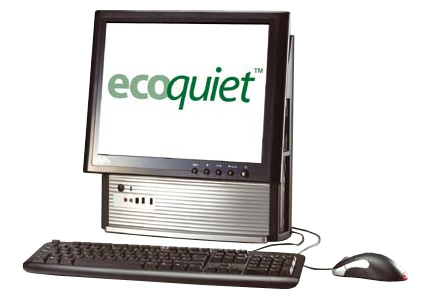ecoquiet RM ONE 50: a first look

RM (formerly Research Machines) is well known as a provider of technology to the UK's schools, colleges and universities. The Oxfordshire-based company is also pretty nimble when it comes to adopting 'hot' new products — witness its distribution deals for the ASUS Eee PC and HP's 2133 Mini-Note PC. The latest hot product to make its way into RM's lineup is the new Atom processor from Intel, which is found in the ecoquiet RM ONE 50.

The ecoquiet RM ONE 50, which ships on 14 July, is a 1.6GHz Atom-based PC with a small footprint, an integrated 17in. monitor and a claimed power usage of less than 50 watts.
Although the 45nm single-core/dual-thread Atom chip has been widely talked up as a CPU for mini-notebooks and even smaller Mobile Internet Devices (MIDs), it will also, in its Diamondville guise, appear in low-cost desktops such as the £548 ecoquiet RM ONE 50, which, as the name suggests, majors on 'green' credentials such as low power and low noise. In particular, the '50' in the model name refers to its claimed power consumption 'under stress (including a monitor)' of less than 50 watts — something we have put to the test in ZDNet UK's labs (see below).
The ecoquiet ONE 50 is built around a new Intel Mini-ITX motherboard, the D945GCLF (codenamed 'Little Falls'), which features a 1.6GHz Atom 230 processor with 512KB of Level 2 cache and a 533MHz frontside bus. The difference between the Diamondville and Silverthorne versions of the Atom chip are basically tweaks to the same underlying architecture: the former is primarily optimised for low cost and has a Thermal Design Power (TPD) rating of 4W, while the latter is primarily optimised for low power consumption and has a TDP of 2W.
The ecoquiet RM ONE 50 is built around Intel's Mini-ITX D945GCLF motherboard: note that the big heatsink and fan are on the 945CG chipset rather than the CPU.
The supporting chipset is Intel's 945GC Express, which includes GMA 950 graphics, Intel High Definition Audio and a PCI Express x1 bus interface. The motherboard has a single memory slot and the ecoquiet RM ONE 50 comes with 1GB of DDR2 RAM, (maximum 2GB). The backplane has two PS/2 ports, serial and parallel connectors, VGA-out, RJ-45 (10/100Mbps Ethernet), four USB 2.0 ports and three audio jacks.
The ecoquiet RM ONE 50 is an all-in-one system with a height- and tilt-adjustable 17in. TFT monitor attached to the side of tower-orientated system unit. The backplane connectors are hidden in a 'cave' at the rear, behind an easy-access panel. The monitor, although integrated, is designed to be relatively easily replaced. At the front there are two USB ports, a FireWire connector, a pair of audio jacks and a volume control. Our review sample had an 80GB hard drive but no optical drive — external 5.25in. and 3.5in. bays are available on the right-hand side of the system unit though.
There are a number of security features, including a padlock-and-bolt system for securing the PC to a desk, a cable clamp to prevent unauthorised tampering with backplane connections and special security screws that should keep the motherboard safe from prying fingers. Teachers will also appreciate the speaker mute switch that sits behind the rear cave door.
Performance and power consumption
We tested the performance of the ecoquiet RM ONE 50 using BAPCo's SYSmark 2007, which is an application-based benchmark that delivers an overall rating and scores in the areas of E-learning, Video creation, Productivity and 3D. The results were as follows:
| SYSmark component | Score |
| E-Learning | 38 |
| Video creation | 39 |
| Productivity | 40 |
| 3D | 30 |
| SYSmark 2007 rating | 37 |
Not surprisingly, the system's integrated graphics and shared video memory ensure that 3D modelling (the 3D test uses Autodesk's 3ds Max 8 and Google's SketchUp 5) is its weakest area. To put the above results in perspective, a high-performance desktop would be expected to score over 150 in every test, so it's clear that the ecoquiet RM ONE 50 is no speed demon. It should do just fine for regular classroom duties though.
We also used our Voltcraft VC940 digital multimeter to record the system's power consumption during the test, the first 20 minutes of which is graphed below:
With the monitor set at 50 per cent brightness, it's evident that, apart from during the reboot at the beginning of the test, the ecoquiet RM ONE 50 uses just over 50W most of the time (the average power consumption was 52W, with a maximum of 58.3W). This is still a significantly lower power consumption than a regular desktop PC: for example, in another workload test we have measured ZDNet's office workhorse (a 2.8GHz Pentium 4 system from HP) delivering an average power consumption of 56W and a peak of 100W. To achieve the claimed sub-50W performance, the monitor brightness needs to be turned down below 50 per cent: it's still readable in normal office or classroom lighting though, so we can just about let RM have that.
Outlook
The ecoquiet RM ONE 50 is specifically targeted at the education market, and looks to be very fit for that purpose. The Atom 230-based D945GCLF motherboard it uses will fit into a much smaller chassis, and when combined with solid-state disks and smaller screens should deliver considerably lower system power consumption than the 50W or so of the system tested here. Performance is by no means stellar, but so long as you don't expect too much of your small-format 'Nettop' (as Intel insists on describing such systems), you shouldn't be disappointed.